|
|
Ferruccio Busoni (Composer, Arranger) |
|
Born: April 1, 1866 - Empoli, Italy
Died: July 27, 1924 - Berlin, Germany |
|
Dante Michaelangelo Benvenuto Ferruccio Busoni was an Italian composer, pianist, music teacher and conductor. |
|
Biography |
|
Ferruccio Busoni was the only child of two professional musicians: his Italian/German mother a pianist, his Italian father a clarinettist. They were often touring during his childhood, and he was brought up in Trieste for the most part. He was a child prodigy. He made his public debut on the piano with his parents, at the age of seven. A couple of years later he played some of his own compositions in Vienna where he heard Franz Liszt play, and met F. Liszt, Johannes Brahms and Anton Rubinstein.
Ferruccio Busoni had a brief period of study in Graz before leaving to Leipzig in 1886. He subsequently held several teaching posts, the first in 1888 at Helsinki, where he met his wife, Gerda Sjöstrand. He taught in Moscow in 1890, and in the USA from 1891 to 1894 where he also toured as a virtuoso pianist. In 1894 he settled in Berlin, giving a series of concerts there both as pianist and conductor. He particularly promoted contemporary music. He also continued to teach in a number of master-classes at Weimar, Vienna and Basel, among his pupils being Claudio Arrau and Egon Petri.
During World War I, Ferruccio Busoni lived first in Bologna, where he directed the conservatory, and later in Zürich. He refused to perform in any countries that were involved in the war. He returned to Berlin in 1920 where he gave master-classes in composition. He had several composition pupils who went on to become famous, including Kurt Weill, Edgard Varèse and Stefan Wolpe.
Ferruccio Busoni died in Berlin from a kidney disease. He was interred in the Städtischen Friedhof III, Berlin-Schöneberg, Stubenrauchstraße 43-45. He left a few recordings of his playing as well as a number of piano rolls. His compositions were largely neglected for many years after his death, but he was remembered as a great virtuoso and arranger of J.S. Bach for the piano. Around the 1980s there was a revival of interest in his compositions. He is commemorated by a plaque at the site of his last residence in Berlin-Schöneberg, Viktoria-Luise-Platz 11. |
|
Busoni's music |
|
The majority of Ferruccio Busoni's works are for the piano. Busoni's music is typically contrapuntally complex, with several melodic lines unwinding at once. Although his music is never entirely atonal in the Schoenbergian sense, his later works are often in indeterminate key. In the program notes for the premiere of his Sonatina seconda of 1912, Busoni calls the work senza tonalità (without tonality). J.S. Bach and F. Liszt are often identified as key influences, though some of his music has a neo-classical bent, and includes melodies resembling W.A. Mozart's.
Some idea of Busoni's mature attitude to composition can be gained from his 1907 manifesto, Sketch of a New Aesthetic of Music, a publication somewhat controversial in its time. As well as discussing then little-explored areas such as electronic music and microtonal music (both techniques he never employed), he asserted that music should distill the essence of music of the past to make something new.
Many of Busoni's works are based on music of the past, especially on the music of J.S. Bach. He arranged several of J.S. Bach's works for the piano, including the famous Toccata and Fugue in D Minor (originally for organ) and the chaconne from the D minor violin partita. Thus some consider him an originator of neoclassicism in music. The first version of Busoni's largest and best known solo piano work, Fantasia Contrappuntistica, was published in 1910. About half an hour in length, it is essentially an extended fantasy on the final incomplete fugue from J.S. Bach's The Art of Fugue. It uses several melodic figures found in J.S. Bach's work, most notably the BACH motif (B flat, A, C, B natural). Busoni revised the work a number of times and arranged it for two pianos. Versions have also been made for organ and for orchestra.
As well as those of J.S. Bach, Ferruccio Busoni used elements of other composers' works. The fourth movement of An die Jugend (1909), for instance, uses two of Niccolo Paganini's Caprices for solo violin (numbers 11 and 15), while the 1920 piece Piano Sonatina No. 6 (Fantasia da camera super Carmen) is based on themes from Georges Bizet's opera Carmen.
Ferruccio Busoni was a virtuoso pianist, and his works for piano are difficult to perform. The Piano Concerto (1904) is probably the largest such work ever written. It lasts for over an hour, requiring great stamina of the soloist, and is written for a large orchestra with a male voice choir in the last movement.
Busoni's suite for orchestra Turandot (1904), probably his most popular orchestral work, was expanded into his opera Turandot in 1917, and Busoni completed two other operas, Die Brautwahl (1911) and Arlecchino (1917). He began serious work on his best known opera, Doktor Faust, in 1916, leaving it incomplete at his death (it was finished by Philipp Jarnach). |
|
Busoni's editions |
|
Ferruccio Busoni also edited of music by other composers. The best known of these is his edition of the complete J.S. Bach solo keyboard works, which he edited with the assistance of his students Egon Petri and Bruno Mugellini. He adds tempo markings, articulation and phrase markings, dynamics and metronome markings to the original J.S. Bach, as well as extensive performance suggestions. In the Goldberg Variations, for example, he suggests cutting eight of the variations for a "concert performance", as well as substantially rewriting many sections. The edition remains controversial, but has recently been reprinted.
On a smaller scale, Busoni edited works by L.v. Beethoven, J. Brahms, Frédéric Chopin, W.A. Mozart, F. Liszt, Arnold Schoenberg and Robert Schumann. The Busoni version of F. Liszt's La Campanella was championed by pianists such as Ignaz Friedman and Josef Lhevinne, and more recently by John Ogdon.
Ferruccio Busoni made a considerable number of piano rolls, and a small number of these have been re-recorded onto vinyl record or CD. His recorded output on gramophone record is much smaller and rarer. |
|
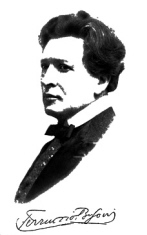
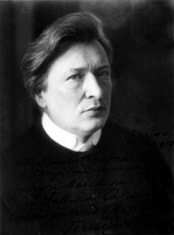
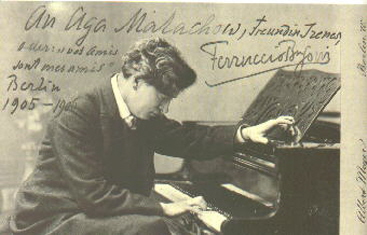
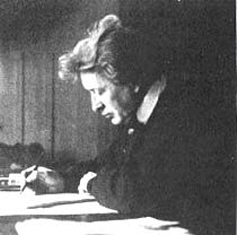 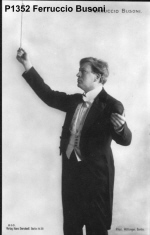
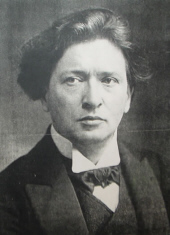
|
|
More Pictures |
|
Source: Wikipedia Website
Contributed by Aryeh Oron (January 2006) |
|
Ferruccio Busoni : Short Biography | Recordings of Instrumental Works
Piano Transcriptions: Works | Recordings: 1900-1949 | 1950-1959 | 1960-1969 | 1970-1979 | 1980-1989 | 1990-1999 | 2000-2009 | 2010-2019 |
|
Arrangements of J.S. Bach's Works |
|
Title |
Chorale Melody |
Year |
|
Durch Adams Fall ist ganz verdebt , transcription for piano (after J.S. Bach, BWV 637; Ten Chorale Preludes No. 7), KiV B27/7 |
Durch Adams Fall ist ganz verderbt |
|
|
Nun komm der heiden Heiland , transcription for piano (after J.S. Bach's BWV 659; Ten Chorale Preludes No. 3), KiV B27/3 |
Nun komm, der Heiden Heiland |
|
|
Improvisation on the Bach Chorale Wie wohl ist mir, o Freund der Seele, for 2 pianos (after BWV 517), KiV 271 |
Wie wohl ist mir |
1916 |
|
Links to other Sites |
|
Ferruccio Dante Michelangiolo Benvenuto Busoni Website (Rondoni)
Ferruccio Busoni - Prophet of Electronic Music
Ferruccio Busoni (Karadar)
Busoni Discography |
Ferruccio Busoni (Wikipedia)
Ferruccio Busoni (Answers.com)
Allmusic: Ferruccio Busoni > Overview
Busoni, Ferruccio (1866 - 1924) (Naxos) |
|
Bibliography |
|
Larry Sitsky: Busoni and the Piano. Published 1986 by Greenwood Press.
The Piano Quarterly Issue No. 108 (Winter 1979-80) has Busoni as the feature composer. Interviews with Gunnar Johansen and Guido Agosti. |
|
|